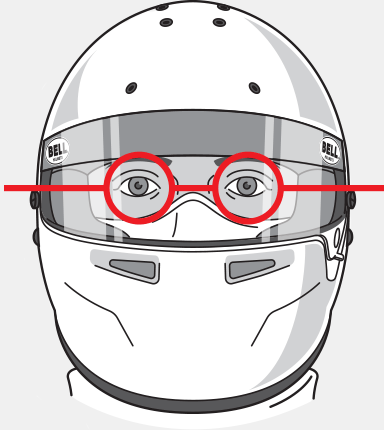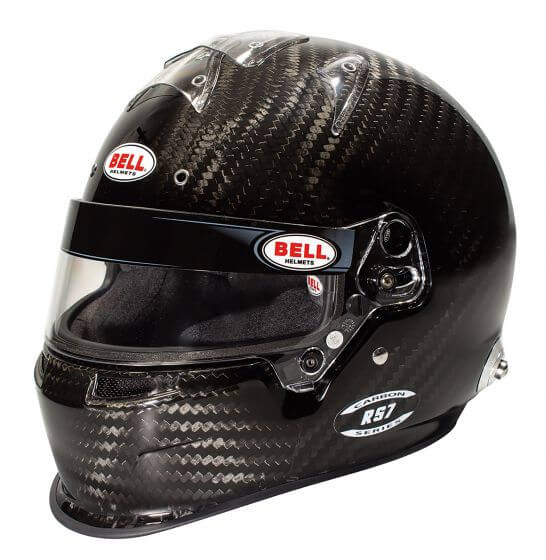BELL | RS7 Carbon | Racing Helmet | Semi-PRO Level | Snell SA2020 & FIA 8859
BELL | RS7 Carbon | Racing Helmet | Semi-PRO Level | Snell SA2020 & FIA 8859
Couldn't load pickup availability
ULTRA-LIGHTWEIGHT CARBON SHEEL HELMET FOR MAXIMUM PERFORMANCE
Embrace the pinnacle of racing safety and performance with the RS7 Carbon Professional Racing Helmet. Born from the innovative HP7 design and perfected with an ultra-lightweight carbon shell, this helmet sets the gold standard for professional racing drivers who demand nothing less than the best. Bell™s proprietary high-pressure molding system ensures that each helmet offers unmatched acoustic comfort, aerodynamic efficiency, and superior energy absorption capabilities.
Key Features
- Homologation: Fully compliant with Snell SA2020 and FIA8859 standards.
- Superior Impact Protection – Multi-density, multi-piece liner optimizes energy absorption for maximum safety.
- Unmatched Visibility – Optical-grade, injection-molded DSAF visor prevents fogging and ensures crystal-clear vision.
- Advanced Ventilation System – 14 air intake and extraction channels provide superior airflow, keeping drivers cool under pressure
- Customizable Aerodynamics – Available with duckbill or non-duckbill options, plus rear spoilers and chin bar gurneys for tailored performance.
Homologation:
- Snell SA2020, FIA 8859-2015 certified.
GET READY TO RACE – ORDER YOURS NOW!
Share
Collapsible content
EXTRA TECH INFORMATION
BELL HELMET SIZING CHART

HOW TO MEASURE HEAD FOR HELMET SIZING
Proper helmet fit is vital to the performance of a helmet during an impact. For maximum protection the helmet must fit properly with the chin strap securely fastened and provide adequate peripheral vision.
Measuring the head is only a starting point for the entire sizing procedure. Due to varying shapes, heads that are apparently the same size when measured by a tape may not necessarily fit the same size helmet.
A small metal tape measure or a cloth tape may be used to make your initial measurement. You can also use a string, which can then be laid against a measuring tape.

Proper Helmet Fit
When properly fitted, the helmet should be worn low on the brow, the eyes near the center of the eye opening, touching the top of the head with uniform and firm pressure all around - tight without excessive pressure points.

The circumference of the head should be measured at a point approximately one inch above the eyebrows in front, and at a point in the back of the head that results in the largest possible measurement. Take several measurements. The largest measurement is the one you want to try on first. If you use a balaclava or head sock, always measure and fit the helmet with it on. Use the Bell sizing chart to determine the size that best matches the head measurement.

8
BELL - Helmet Care & Maintenance
How to Properly Care for Your Racing Helmet
Your racing helmet is one of the most important pieces of safety equipment you own. Proper care and maintenance ensure that it remains in peak condition, providing the highest level of protection on the track. Whether you're an auto racing driver or a karting enthusiast, following these care guidelines will help prolong the life of your helmet and maintain its race-ready performance.
Exterior Care
All BELL & B2 Helmets are finished with a tough, polyurethane coating designed to resist scratches and environmental wear. However, to maintain the pristine condition of your helmet, proper cleaning and handling are essential.
-
Use automotive-grade cleaning products: Choose only high-quality cleaners that are safe for automotive finishes. Avoid household or industrial cleaners that contain harsh chemicals.
-
Avoid abrasive materials: Never use rough sponges, scouring pads, or any abrasive cloths that may scratch or dull the helmet’s finish.
-
Keep away from solvents: Solvent-based cleaners can weaken the helmet’s protective coating and compromise its integrity.
-
Handle with care: Always place your helmet on a soft surface when not in use and avoid dropping or knocking it against hard surfaces.
-
Shield care: Use a microfiber cloth and water or a helmet-specific cleaning spray to remove dirt and smudges from the visor without causing scratches.
Interior Care
The interior of your helmet absorbs sweat, oils, and dirt over time, which can affect both comfort and hygiene. Keeping the interior clean helps maintain a fresh feel and prolongs the fit and function of your helmet’s padding.
-
Use mild soap and water: When cleaning the interior fit pads and lining, hand wash gently with a soft cloth and mild soap. Avoid submerging the helmet in water.
-
Allow proper drying time: If the interior becomes damp from sweat or cleaning, let it air dry completely before storage. Avoid direct heat sources like hairdryers, as excessive heat can damage the helmet’s inner materials.
-
Use moisture-wicking helmet liners: If your helmet does not have a removable liner, consider wearing a moisture-wicking balaclava to absorb sweat and keep the interior cleaner for longer.
-
Deodorize as needed: Use helmet-safe odor neutralizers or sprays designed for racing gear to keep your helmet smelling fresh.
Storage Tips
Proper storage of your helmet is just as important as regular cleaning. Follow these tips to ensure your helmet remains in top condition between races:
-
Store in a cool, dry place: Keep your helmet away from direct sunlight and extreme temperatures, as heat can weaken the helmet’s materials.
-
Use a helmet bag: A padded helmet bag provides extra protection against dust, dirt, and accidental damage.
-
Keep away from chemicals and fumes: Gasoline, cleaning agents, and other harsh chemicals can deteriorate the helmet shell and interior over time.
-
Avoid hanging your helmet on mirrors or hooks: This can cause unnecessary pressure on the interior padding and weaken its structure.
When to Replace Your Helmet
Even with proper care, racing helmets have a lifespan. Most manufacturers, including Bell, recommend replacing your helmet every 5 years from the date of manufacture or sooner if it has sustained any significant impact. Look for signs of wear such as:
-
Cracks or visible damage to the shell
-
Loose or deteriorating interior padding
-
Compromised strap integrity
-
Outdated safety certifications required for racing
If in doubt, always consult the manufacturer or your racing organization to determine if your helmet is still safe for use.
By following these care and maintenance guidelines, you can ensure that your helmet remains in optimal condition, providing the best protection and comfort on the track. A well-maintained helmet is a safe helmet—treat yours with the care it deserves!
Contact Us
If you have any questions about helmet care or need further guidance, feel free to contact us. Additionally, check out our extended product range of Bell Helmets and B2 Helmets to find the perfect fit for your racing needs!



